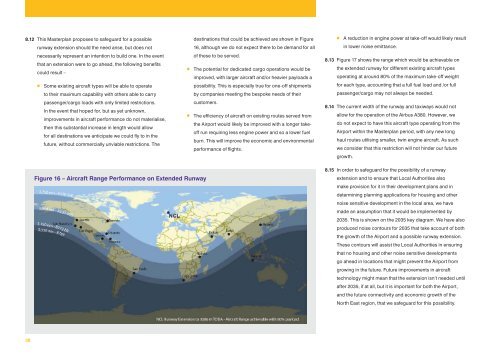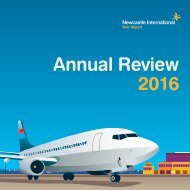Airport Masterplan 2035 LOW RES
You also want an ePaper? Increase the reach of your titles
YUMPU automatically turns print PDFs into web optimized ePapers that Google loves.
<strong>Masterplan</strong> <strong>2035</strong><br />
8.12 This <strong>Masterplan</strong> proposes to safeguard for a possible<br />
runway extension should the need arise, but does not<br />
destinations that could be achieved are shown in Figure<br />
16, although we do not expect there to be demand for all<br />
l A reduction in engine power at take-off would likely result<br />
in lower noise emittance.<br />
8.16 There are number of implications which would stem from<br />
such a possible extension –<br />
8.19 The current runway capacity is 30 aircraft movements<br />
an hour in total, with no more than 18 departures and 12<br />
8.21 The location of the terminal at one end of the runway does<br />
not make for the most efficient airside operation as taxiways<br />
necessarily represent an intention to build one. In the event<br />
of these to be served.<br />
that an extension were to go ahead, the following benefits<br />
l The potential for dedicated cargo operations would be<br />
could result –<br />
improved, with larger aircraft and/or heavier payloads a<br />
l Some existing aircraft types will be able to operate<br />
possibility. This is especially true for one-off shipments<br />
to their maximum capability with others able to carry<br />
by companies meeting the bespoke needs of their<br />
passenger/cargo loads with only limited restrictions.<br />
customers.<br />
In the event that hoped for, but as yet unknown,<br />
l The efficiency of aircraft on existing routes served from<br />
improvements in aircraft performance do not materialise,<br />
the <strong>Airport</strong> would likely be improved with a longer takeoff<br />
run requiring less engine power and so a lower fuel<br />
then this substantial increase in length would allow<br />
for all destinations we anticipate we could fly to in the<br />
burn. This will improve the economic and environmental<br />
future, without commercially unviable restrictions. The<br />
performance of flights.<br />
Figure 16 – Aircraft Range Performance on Extended Runway<br />
8.13 Figure 17 shows the range which would be achievable on<br />
the extended runway for different existing aircraft types<br />
operating at around 80% of the maximum take-off weight<br />
for each type, accounting that a full fuel load and /or full<br />
passenger/cargo may not always be needed.<br />
8.14 The current width of the runway and taxiways would not<br />
allow for the operation of the Airbus A380. However, we<br />
do not expect to have this aircraft type operating from the<br />
<strong>Airport</strong> within the <strong>Masterplan</strong> period, with any new long<br />
haul routes utilising smaller, twin engine aircraft. As such<br />
we consider that this restriction will not hinder our future<br />
growth.<br />
8.15 In order to safeguard for the possibility of a runway<br />
extension and to ensure that Local Authorities also<br />
make provision for it in their development plans and in<br />
determining planning applications for housing and other<br />
noise sensitive development in the local area, we have<br />
made an assumption that it would be implemented by<br />
<strong>2035</strong>. This is shown on the <strong>2035</strong> key diagram. We have also<br />
produced noise contours for <strong>2035</strong> that take account of both<br />
l The runway would extend onto agricultural land which<br />
is currently within the Green Belt. However, we believe<br />
that the openness of the Green Belt would be preserved<br />
as well as the separation of settlements. Combined with<br />
the economic benefits the development would bring,<br />
we think there is a compelling case for very special<br />
circumstances so that the development could be<br />
supported, as per paragraphs 79-92 of the NPPF.<br />
l This land is not under the <strong>Airport</strong>’s ownership. Should<br />
a runway extension go ahead, the <strong>Airport</strong> Company will<br />
seek the purchase of this land by negotiation, but it does<br />
have compulsory purchase powers as a last resort.<br />
l There would be a change to arrivals and departures<br />
which would result in aircraft being at different heights<br />
than they currently are when flying over certain areas.<br />
This will result in a slightly larger population potentially<br />
being impacted by aircraft noise. This is addressed in<br />
section 10.<br />
l The Public Safety Zone at the eastern end of the runway<br />
would move, resulting in land to the North of Brunswick<br />
Village being subject to development restrictions.<br />
arrivals (or vice versa). Corresponding with the peaks and<br />
troughs of terminal passenger throughput, there are times<br />
when aircraft movements are concentrated. However,<br />
analysis of our forecast peak day schedules indicates that<br />
future demand can be comfortably accommodated within<br />
the existing runway capacity. It is therefore not considered<br />
that there is any need for an additional runway up to <strong>2035</strong>.<br />
Indeed there are many single runway airports which operate<br />
well in excess of our projected future passengers numbers.<br />
8.20 Although there is sufficient capacity to provide for growth,<br />
we will consider making improvements to make sure use<br />
of current infrastructure is as efficient as possible, and so<br />
maximise use of the existing airfield.<br />
mix with aircraft stands in quite a confined space. This can<br />
sometimes delay arriving aircraft getting onto their stand or<br />
restrict use of taxiways when departing aircraft are pushing<br />
back. Two definite pinch points have been identified.<br />
8.22 At present the <strong>Airport</strong> has a ‘holding taxiway’ at the western<br />
end of the runway for aircraft ready to depart. They will hold<br />
on this area until given clearance for take-off by ATC. There<br />
is currently only space for 2 narrow body aircraft to wait at<br />
any one time, as any more results in access to the stands<br />
south of the pier being blocked. This can result in aircraft<br />
waiting on stands longer than is necessary. A widening of<br />
this taxiway would allow for dual queuing and so improve<br />
the efficiency of the airfield, as shown in Figure 17.<br />
the growth of the <strong>Airport</strong> and a possible runway extension.<br />
These contours will assist the Local Authorities in ensuring<br />
that no housing and other noise sensitive developments<br />
go ahead in locations that might prevent the <strong>Airport</strong> from<br />
growing in the future. Future improvements in aircraft<br />
technology might mean that the extension isn’t needed until<br />
Runway and Taxiway Capacity<br />
8.17 The capacity of the runway dictates how many aircraft<br />
can safely operate in a given period. It is measured in<br />
movements per hour, and can be influenced by a number of<br />
factors such as aircraft type, weather, taxiway provision, air<br />
space restrictions, and safety and regulatory requirements.<br />
after <strong>2035</strong>, if at all, but it is important for both the <strong>Airport</strong>,<br />
and the future connectivity and economic growth of the<br />
North East region, that we safeguard for this possibility.<br />
8.18 The <strong>Airport</strong> currently has two rapid exit taxiways to allow<br />
for aircraft to clear the runway as quickly as possible after<br />
landing, and a parallel taxiway, which removes the necessity<br />
for aircraft to taxi on the runway itself. These features<br />
provide quite a high existing capacity for our single runway.<br />
38<br />
39




